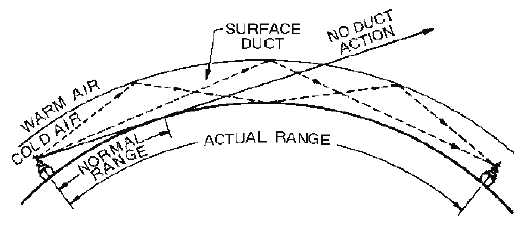2-36
distances are possible because of the different densities and refractive qualities of warm and cool air. The
sudden change in density when a radio wave enters the warm air above a duct causes the wave to be
refracted back toward Earth. When the wave strikes the Earth or a warm layer below the duct, it is again
reflected or refracted upward and proceeds on through the duct with a multiple-hop type of action. An
example of the propagation of radio waves by ducting is shown in figure 2-25.
Figure 2-25.—Duct effect caused by temperature inversion.
Q42. How do raindrops affect radio waves?
Q43. How does fog affect radio waves at frequencies above 2 gigahertz?
Q44. How is the term "temperature inversion" used when referring to radio waves?
Q45. How does temperature inversion affect radio transmission?
TROPOSPHERIC PROPAGATION
As the lowest region of the Earth's atmosphere, the troposphere extends from the Earth's surface to a
height of slightly over 7 miles. Virtually all weather phenomena occur in this region. Generally, the
troposphere is characterized by a steady decrease in both temperature and pressure as height is increased.
However, the many changes in weather phenomena cause variations in humidity and an uneven heating of
the Earth's surface. As a result, the air in the troposphere is in constant motion. This motion causes small
turbulences, or eddies, to be formed, as shown by the bouncing of aircraft entering turbulent areas of the
atmosphere. These turbulences are most intense near the Earth's surface and gradually diminish with
height. They have a refractive quality that permits the refracting or scattering of radio waves with short
wavelengths. This scattering provides enhanced communications at higher frequencies.
Recall that in the relationship between frequency and wavelength, wavelength decreases as
frequency increases and vice versa. Radio waves of frequencies below 30 megahertz normally have
wavelengths longer than the size of weather turbulences. These radio waves are, therefore, affected very
little by the turbulences. On the other hand, as the frequency increases into the vhf range and above, the
wavelengths decrease in size, to the point that they become subject to tropospheric scattering. The usable
frequency range for tropospheric scattering is from about 100 megahertz to 10 gigahertz.



